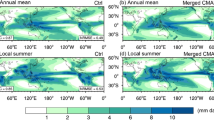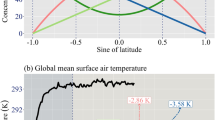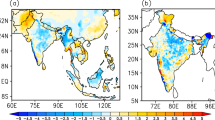Abstract
Climate intervention through deliberate injection of sulfate aerosols into the stratosphere is one of the proposed solar radiation modification options to counteract some of the adverse effects of climate change. Although this approach can offset global mean temperature change, several studies have shown that there will be large residual and overcompensating regional changes. In this study, we estimate the impact of varying the latitudinal position of aerosol injection on the global monsoon precipitation in the RCP8.5 scenario by analyzing single point injection simulations from CESM1 where 12 teragram (Tg) of sulfur dioxide (SO2) are injected each year into the stratosphere at latitudes 30° S, 15° S, equator, 15° N, and 30° N. During the period 2043–2049, relative to RCP8.5, the hemispheric mean summer monsoon precipitation decreases in the hemisphere where aerosols are injected but increases in the opposite hemisphere. The hemispheric mean monsoon precipitation changes by up to ± 10% depending on the injection location. The changes in precipitation are linked to the changes in interhemispheric temperature difference and shifts in the intertropical convergence zone. The summer monsoon precipitation over India decreases by about 21% for 15° N and 29% for 30° N injections. Thus, adverse effects are likely for regions such as India when aerosols are injected at 15° N, though injection at 15° N has been shown to be more efficient in cooling the global climate in a recent study. Our study highlights the likelihood of climate interventions leading to large regional disruptions while attempting to keep the global mean climate within a safe limit.








Similar content being viewed by others
Data availability
The model outputs from the SO2 injection matrix simulations are available at https://www.earthsystemgrid.org/dataset/ucar.cgd.ccsm4.so2_geoeng.html (https://doi.org/10.5065/D6X63KMM), and the GLENS control simulations are available at https://www.earthsystemgrid.org/dataset/ucar.cgd.ccsm4.GLE.Control.html (https://doi.org/10.5065/D6JH3JXX).
Code availability
The codes used for the current study are available from the corresponding author on reasonable request.
References
Adam O, Bischoff T, Schneider T (2016) Seasonal and interannual variations of the energy flux Equator and ITCZ. Part I: zonally averaged ITCZ position. J Clim 29:3219–3230. https://doi.org/10.1175/JCLI-D-15-0512.1
Atwood AR, Donohoe A, Battisti DS et al (2020) Robust longitudinally variable responses of the ITCZ to a myriad of climate forcings. Geophys Res Lett 47:e2020GL088833. https://doi.org/10.1029/2020GL088833
Bala G, Duffy PB, Taylor KE (2008) Impact of geoengineering schemes on the global hydrological cycle. Proc Natl Acad Sci 105:7664–7669. https://doi.org/10.1073/pnas.0711648105
Bala G, Caldeira K, Nemani R (2010) Fast versus slow response in climate change: implications for the global hydrological cycle. Clim Dyn 35:423–434. https://doi.org/10.1007/s00382-009-0583-y
Ban-Weiss GA, Caldeira K (2010) Geoengineering as an optimization problem. Environ Res Lett 5:034009. https://doi.org/10.1088/1748-9326/5/3/034009
Bethke I, Outten S, Otterå OH et al (2017) Potential volcanic impacts on future climate variability. Nature Clim Change 7:799–805. https://doi.org/10.1038/nclimate3394
Budyko MI (1977) Climatic changes. American Geophysical Union, Washington, D. C.
Caldeira K, Bala G, Cao L (2013) The science of geoengineering. Annu Rev Earth Planet Sci 41:231–256. https://doi.org/10.1146/annurev-earth-042711-105548
Cao L, Duan L, Bala G, Caldeira K (2017) Simultaneous stabilization of global temperature and precipitation through cocktail geoengineering. Geophys Res Lett 44:7429–7437. https://doi.org/10.1002/2017GL074281
Cao J, Wang B, Wang B et al (2020) Sources of the intermodel spread in projected global monsoon hydrological sensitivity. Geophys Res Lett 47:e2020GL089560. https://doi.org/10.1029/2020GL089560
Crutzen PJ (2006) Albedo enhancement by stratospheric sulfur injections: a contribution to resolve a policy dilemma? Clim Change 77:211–219. https://doi.org/10.1007/s10584-006-9101-y
Devaraju N, Bala G, Modak A (2015) Effects of large-scale deforestation on precipitation in the monsoon regions: remote versus local effects. Proc Natl Acad Sci 112:3257–3262. https://doi.org/10.1073/pnas.1423439112
Donohoe A, Battisti DS (2012) What determines meridional heat transport in climate models? J Clim 25:3832–3850. https://doi.org/10.1175/JCLI-D-11-00257.1
Donohoe A, Marshall J, Ferreira D, Mcgee D (2013) The relationship between ITCZ location and cross-equatorial atmospheric heat transport: from the seasonal cycle to the last glacial maximum. J Clim 26:3597–3618. https://doi.org/10.1175/JCLI-D-12-00467.1
Efron B, Tibshirani RJ (1993) An introduction to the bootstrap. Springer, Boston
Fadnavis S, Müller R, Chakraborty T et al (2021) The role of tropical volcanic eruptions in exacerbating Indian droughts. Sci Rep 11:2714 (10/gj74mx)
Fasullo JT, Otto-Bliesner BL, Stevenson S (2019) The influence of volcanic aerosol meridional structure on monsoon responses over the last millennium. Geophys Res Lett 46:12350–12359. https://doi.org/10.1029/2019GL084377
Ferraro AJ, Highwood EJ, Charlton-Perez AJ (2014) Weakened tropical circulation and reduced precipitation in response to geoengineering. Environ Res Lett 9:014001. https://doi.org/10.1088/1748-9326/9/1/014001
Friedman AR, Hwang Y-T, Chiang JCH, Frierson DMW (2013) Interhemispheric temperature asymmetry over the twentieth century and in future projections. J Clim 26:5419–5433. https://doi.org/10.1175/JCLI-D-12-00525.1
Frierson DMW, Hwang Y-T (2012) Extratropical influence on ITCZ shifts in slab ocean simulations of global warming. J Clim 25:720–733. https://doi.org/10.1175/JCLI-D-11-00116.1
Gadgil S (2003) The Indian monsoon and its variability. Annu Rev Earth Planet Sci 31:429–467. https://doi.org/10.1146/annurev.earth.31.100901.141251
Gadgil S (2018) The monsoon system: land–sea breeze or the ITCZ? J Earth Syst Sci 127:1. https://doi.org/10.1007/s12040-017-0916-x
Gadgil S, Gadgil S (2006) The Indian monsoon, GDP and agriculture. Econ Polit Wkly 41:4887–4895. https://doi.org/10.2307/4418949
Goswami BN, Chakravorty S (2017) Dynamics of the Indian summer monsoon climate. Oxford research encyclopedia of climate science. Oxford University Press, Oxford, pp 1–36
Harrop BE, Lu J, Liu F et al (2018) Sensitivity of the ITCZ location to ocean forcing via Q-Flux Green’s function experiments. Geophys Res Lett 45:13116–13123. https://doi.org/10.1029/2018GL080772
Haywood JM, Jones A, Bellouin N, Stephenson D (2013) Asymmetric forcing from stratospheric aerosols impacts Sahelian rainfall. Nat Clim Chang 3:660–665. https://doi.org/10.1038/nclimate1857
IPCC (2013) Climate Change 2013: The physical science basis. Contribution of working Group I to the fifth assessment report of the intergovernmental panel on climate change. Cambridge University Press, Cambridge
IPCC (2018) Global warming of 1.5 °C. An IPCC special report on the impacts of global warming of 1.5 °C above pre-industrial levels and related global greenhouse gas emission pathways, in the context of strengthening the global response to the threat of climate change. UN Intergovernmental Panel on Climate Change, Geneva
Jacobson TWP, Yang W, Vecchi GA, Horowitz LW (2020) Impact of volcanic aerosol hemispheric symmetry on Sahel rainfall. Clim Dyn 55:1733–1758. https://doi.org/10.1007/s00382-020-05347-7
Kleinschmitt C, Boucher O, Platt U (2018) Sensitivity of the radiative forcing by stratospheric sulfur geoengineering to the amount and strategy of the SO 2 injection studied with the LMDZ-S3A model. Atmos Chem Phys 18:2769–2786. https://doi.org/10.5194/acp-18-2769-2018
Kravitz B, MacMartin DG (2020) Uncertainty and the basis for confidence in solar geoengineering research. Nat Rev Earth Environ 1:64–75. https://doi.org/10.1038/s43017-019-0004-7
Kravitz B, Robock A, Boucher O et al (2011) The geoengineering model intercomparison project (GeoMIP). Atmos Sci Lett 12:162–167. https://doi.org/10.1002/asl.316
Kravitz B, MacMartin DG, Mills MJ et al (2017) First simulations of designing stratospheric sulfate aerosol geoengineering to meet multiple simultaneous climate objectives. J Geophys Res Atmos 122:12616–12634. https://doi.org/10.1002/2017JD026874
Kravitz B, MacMartin DG, Tilmes S et al (2019) Comparing surface and stratospheric impacts of geoengineering with different SO2 injection strategies. J Geophys Res Atmos 124:7900–7918. https://doi.org/10.1029/2019JD030329
Krishnamohan KS, Bala G, Cao L et al (2019) Climate system response to stratospheric sulfate aerosols: sensitivity to altitude of aerosol layer. Earth Syst Dyn 10:885–900. https://doi.org/10.5194/esd-10-885-2019
Krishnamohan KS, Bala G, Cao L et al (2020) the climatic effects of hygroscopic growth of sulfate aerosols in the stratosphere. Earth’s Futur 8:e2019EF001326. https://doi.org/10.1029/2019EF001326
Krishnamohan KS, Modak A, Bala G (2021) Effects of local and remote black carbon aerosols on summer monsoon precipitation over India. Environ Res Commun 3:081003. https://doi.org/10.1088/2515-7620/ac18d1
Laakso A, Korhonen H, Romakkaniemi S, Kokkola H (2017) Radiative and climate effects of stratospheric sulfur geoengineering using seasonally varying injection areas. Atmos Chem Phys 17:6957–6974. https://doi.org/10.5194/acp-17-6957-2017
Liu F, Chai J, Wang B et al (2016) Global monsoon precipitation responses to large volcanic eruptions. Sci Rep 6:24331. https://doi.org/10.1038/srep24331
Lutsko NJ, Seeley JT, Keith DW (2020) Estimating impacts and trade-offs in solar geoengineering scenarios with a moist energy balance model. Geophys Res Lett 47:e2020GL087290. https://doi.org/10.1029/2020GL087290
MacCracken MC, Shin H-J, Caldeira K, Ban-Weiss GA (2013) Climate response to imposed solar radiation reductions in high latitudes. Earth Syst Dyn 4:301–315. https://doi.org/10.5194/esd-4-301-2013
MacMartin DG, Kravitz B, Tilmes S et al (2017) The climate response to stratospheric aerosol geoengineering can be tailored using multiple injection locations. J Geophys Res Atmos 122:12574–12590. https://doi.org/10.1002/2017JD026868
Manabe S, Spelman MJ, Stouffer RJ (1992) Transient responses of a coupled ocean-atmosphere model to gradual changes of atmospheric CO2. Part II: seasonal response. J Clim 5:105–126. https://doi.org/10.1175/1520-0442(1992)005%3c0105:TROACO%3e2.0.CO;2
Marsh DR, Mills MJ, Kinnison DE et al (2013) Climate change from 1850 to 2005 simulated in CESM1(WACCM). J Clim 26:7372–7391. https://doi.org/10.1175/JCLI-D-12-00558.1
Matus AV, L’Ecuyer TS, Kay JE et al (2015) The role of clouds in modulating global aerosol direct radiative effects in spaceborne active observations and the community earth system model. J Clim 28:2986–3003. https://doi.org/10.1175/JCLI-D-14-00426.1
Mills MJ, Richter JH, Tilmes S et al (2017) Radiative and chemical response to interactive stratospheric sulfate aerosols in fully coupled CESM1(WACCM). J Geophys Res Atmos 122:13061–13078. https://doi.org/10.1002/2017JD027006
Modak A, Bala G (2014) Sensitivity of simulated climate to latitudinal distribution of solar insolation reduction in solar radiation management. Atmos Chem Phys 14:7769–7779. https://doi.org/10.5194/acp-14-7769-2014
Myhre G, Myhre CEL, Samset BH, Storelvmo T (2013) Aerosols and their relation to global climate and climate sensitivity. Nat Educ Knowl 4:7
Nalam A, Bala G, Modak A (2018) Effects of Arctic geoengineering on precipitation in the tropical monsoon regions. Clim Dyn 50:3375–3395. https://doi.org/10.1007/s00382-017-3810-y
Niemeier U, Schmidt H, Alterskjaer K, Kristjánsson JE (2013) Solar irradiance reduction via climate engineering: Impact of different techniques on the energy balance and the hydrological cycle. J Geophys Res Atmos 118:11905–11917. https://doi.org/10.1002/2013JD020445
Ocko IB, Ramaswamy V, Ming Y (2014) Contrasting climate responses to the scattering and absorbing features of anthropogenic aerosol forcings. J Clim 27:5329–5345. https://doi.org/10.1175/JCLI-D-13-00401.1
Pope FD, Braesicke P, Grainger RG et al (2012) Stratospheric aerosol particles and solar-radiation management. Nat Clim Chang 2:713–719. https://doi.org/10.1038/nclimate1528
Ramanathan V, Chung C, Kim D et al (2005) Atmospheric brown clouds: Impacts on South Asian climate and hydrological cycle. Proc Natl Acad Sci 102:5326–5333. https://doi.org/10.1073/pnas.0500656102
Ramaswamy V, Chen C-T (1997) Linear additivity of climate response for combined albedo and greenhouse perturbations. Geophys Res Lett 24:567–570. https://doi.org/10.1029/97GL00248
Richter JH, Tilmes S, Mills MJ et al (2017) Stratospheric dynamical response and ozone feedbacks in the presence of SO2 injections. J Geophys Res Atmos 122:12557–12573. https://doi.org/10.1002/2017JD026912
Robock A, Oman L, Stenchikov GL (2008) Regional climate responses to geoengineering with tropical and Arctic SO2 injections. J Geophys Res Atmos 113:D16101. https://doi.org/10.1029/2008JD010050
Rockström J, Steffen W, Noone K et al (2009) A safe operating space for humanity. Nature 461:472–475. https://doi.org/10.1038/461472a
Schmidt H, Alterskjær K, Bou Karam D et al (2012) Solar irradiance reduction to counteract radiative forcing from a quadrupling of CO2: climate responses simulated by four earth system models. Earth Syst Dyn 3:63–78. https://doi.org/10.5194/esd-3-63-2012
Schneider T, Bischoff T, Haug GH (2014) Migrations and dynamics of the intertropical convergence zone. Nature 513:45–53. https://doi.org/10.1038/nature13636
Seeley JT, Lutsko NJ, Keith DW (2021) Designing a radiative antidote to CO2. Geophys Res Lett 48:e2020GL090876. https://doi.org/10.1029/2020GL090876
Seo J, Kang SM, Frierson DMW (2014) Sensitivity of intertropical convergence zone movement to the latitudinal position of thermal forcing. J Clim 27:3035–3042. https://doi.org/10.1175/JCLI-D-13-00691.1
Simpson IR, Tilmes S, Richter JH et al (2019) The regional hydroclimate response to stratospheric sulfate geoengineering and the role of stratospheric heating. J Geophys Res Atmos 124:12587–12616. https://doi.org/10.1029/2019JD031093
Smyth JE, Russotto RD, Storelvmo T (2017) Thermodynamic and dynamic responses of the hydrological cycle to solar dimming. Atmos Chem Phys 17:6439–6453. https://doi.org/10.5194/acp-17-6439-2017
Steffen W, Richardson K, Rockstrom J et al (2015) Planetary boundaries: guiding human development on a changing planet. Science 347:1259855. https://doi.org/10.1126/science.1259855
Steffen W, Rockström J, Richardson K et al (2018) Trajectories of the earth system in the anthropocene. Proc Natl Acad Sci 115:8252–8259. https://doi.org/10.1073/pnas.1810141115
Sun W, Wang B, Chen D et al (2020) Global monsoon response to tropical and Arctic stratospheric aerosol injection. Clim Dyn 55:2107–2121. https://doi.org/10.1007/s00382-020-05371-7
Tilmes S, Fasullo JT, Lamarque J-F et al (2013) The hydrological impact of geoengineering in the Geoengineering Model Intercomparison Project (GeoMIP). J Geophys Res Atmos 118:11036–11058. https://doi.org/10.1002/jgrd.50868
Tilmes S, Richter JH, Mills MJ et al (2017) Sensitivity of aerosol distribution and climate response to stratospheric SO2 injection locations. J Geophys Res Atmos 122:12591–12615. https://doi.org/10.1002/2017JD026888
Tilmes S, Richter JH, Kravitz B et al (2018) CESM1(WACCM) stratospheric aerosol geoengineering large ensemble project. Bull Am Meteorol Soc 99:2361–2371. https://doi.org/10.1175/BAMS-D-17-0267.1
United Nations Population Division (2000) World population prospects: The 1998 Revision. United Nations Publications, London
Visioni D, MacMartin DG, Kravitz B et al (2019) Seasonal injection strategies for stratospheric aerosol geoengineering. Geophys Res Lett 46:7790–7799. https://doi.org/10.1029/2019GL083680
Visioni D, MacMartin DG, Kravitz B et al (2020) Seasonally modulated stratospheric aerosol geoengineering alters the climate outcomes. Geophys Res Lett 47:e2020GL088337. https://doi.org/10.1029/2020GL088337
Wang B, Ding Q (2006) Changes in global monsoon precipitation over the past 56 years. Geophys Res Lett 33:L06711. https://doi.org/10.1029/2005GL025347
Wang B, Ding Q (2008) Global monsoon: dominant mode of annual variation in the tropics. Dyn Atmos Ocean 44:165–183. https://doi.org/10.1016/j.dynatmoce.2007.05.002
Wang B, Lin H (2002) Rainy season of the Asian-Pacific summer monsoon. J Clim 15:386–398. https://doi.org/10.1175/1520-0442(2002)015%3c0386:RSOTAP%3e2.0.CO;2
Weisenstein DK, Keith DW, Dykema JA (2015) Solar geoengineering using solid aerosol in the stratosphere. Atmos Chem Phys 15:11835–11859. https://doi.org/10.5194/acp-15-11835-2015
Wu R, Kirtman BP (2003) On the impacts of the Indian summer monsoon on ENSO in a coupled GCM. Q J R Meteorol Soc 129:3439–3468. https://doi.org/10.1256/qj.02.214
Zelinka MD, Andrews T, Forster PM, Taylor KE (2014) Quantifying components of aerosol-cloud-radiation interactions in climate models. J Geophys Res Atmos 119:7599–7615. https://doi.org/10.1002/2014JD021710
Zipper SC, Jaramillo F, Wang-Erlandsson L et al (2020) Integrating the water planetary boundary with water management from local to global scales. Earth’s Futur 8:e20190EF01377. https://doi.org/10.1029/2019EF001377
Zuo M, Zhou T, Man W (2019) Hydroclimate responses over global monsoon regions following volcanic eruptions at different latitudes. J Clim 32:4367–4385. https://doi.org/10.1175/JCLI-D-18-0707.1
Acknowledgements
The authors thank the National Center for Atmospheric Research—Climate Variability and Change Working Group and the researchers who produced the SO2 injection matrix and GLENS simulations.
Funding
This work was funded by the Department of Science and Technology (DST), India Grant DST/CCP/MRDP/96/2017 (G) and the Ministry of Earth Sciences (MoES), India Grant MOES/PAMC/H&C/41/2013-PC-II.
Author information
Authors and Affiliations
Contributions
KSK and GB contributed equally to this work.
Corresponding author
Ethics declarations
Conflict of interest
The authors declare no conflict of interest.
Additional information
Publisher's Note
Springer Nature remains neutral with regard to jurisdictional claims in published maps and institutional affiliations.
Supplementary Information
Below is the link to the electronic supplementary material.
Rights and permissions
About this article
Cite this article
Krishnamohan, K.S., Bala, G. Sensitivity of tropical monsoon precipitation to the latitude of stratospheric aerosol injections. Clim Dyn 59, 151–168 (2022). https://doi.org/10.1007/s00382-021-06121-z
Received:
Accepted:
Published:
Issue Date:
DOI: https://doi.org/10.1007/s00382-021-06121-z




